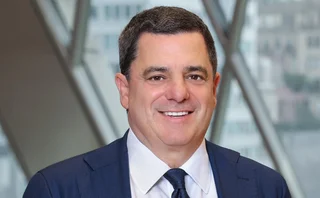
Private Bank of the Year: UBS Wealth Management
Asia Risk Awards 2016

The Asia Risk Awards focus on innovation and best practice, not just market share, but UBS Wealth Management (UBS WM) ticks all three boxes.
The firm's total assets under management in the region now stand at $274 billion, according to research by Asian Private Banker, well ahead of second-placed Citi ($210 billion) and Credit Suisse ($120 billion). But despite its size, UBS WM has managed to stay nimble. The bank's provision of access to Chinese firms in the pre-IPO stage shows its ability to create bespoke products that generate a lot of demand. The same can be said of its chief investment office (CIO), which delivers both short-term relative-value trades – provided by a team of ex-Brevan Howard traders – and long-term strategic investment via structured notes.
Clients clearly recognise the value of these strengths. Although UBS WM added only a modest 0.7% to its total assets under management last year, this was well ahead of Citi, which dropped 17.5%. And it's not only end-users that rate the firm. Asia Risk conducted a straw poll of private bank counterparties and every one of them rates UBS WM as the number one shop in Asia – in stark contrast to Citi, which failed to register a single vote.
Bryan Crawford, Hong Kong-based head of investor services at UBS Wealth Management, says big is beautiful when it comes to wealth management. He points to the bank's CIO function as something that enables it to stay one step ahead of its peers.
"Our advisory capability to clients starts with our CIO function. We invest a billion dollars a year in this and it delivers macro and micro views, which we then communicate to clients and implement in their portfolios."
The global scale of the bank's wealth management arm also enables it to stand out, he says. "UBS WM has $2 trillion dollars in assets under management globally and we are the only wealth manager to have credible strength across the US, Europe and Asia. But scale alone isn't what makes us stand out to clients. It is also our associated ability to source the best products on differentiated terms and provide a strong level of reach and connectivity."
The bank not only provides exclusive investment ideas but also segments them in a way that allows bespoke services depending on an end-user's wealth and sophistication. At the top is the global family office (GFO) tranche, which consists of 100 clients in Asia with assets of more than $500 million. Next comes the ultra-high-net-worth segment and below that is the strand of high-net-worth clients.
This means that GFO clients get direct access to an equity derivatives trading desk at the investment bank – an approach that Crawford says wouldn't be appropriate for other clients. Likewise the senior client segment gets to directly discuss M&A activity.
The segmented approach also applies to product selection. "We have a product risk rating and profiling approach that deals with product, as well as client, suitability. Those clients on our GFO platform are served in a way that recognises their sophistication," he says.
Vivienne Chia, head of structured products for Asia-Pacific at the private bank, says the firm's CIO function provides a range of trading and hedging ideas for clients. In response to demand for strategic investment, for instance, UBS WM constructed a strategic note comprising a pick of 20 Asia stocks.
"That is something where our clients can look for long-term capital appreciation over time, but we also look at their portfolios to see how they can extract value or hedge their existing positions. Hedging is a key area for investors but it is something that is not always straightforward, so the CIO educates them and we come up with products to systematically help clients implement these strategies on a monthly basis."
Equity markets around Asia-Pacific crashed in unison at the start of 2016, leaving some clients with portfolios that were underwater. The CIO function sought out strategies to enable them realise more value from their holdings.
"How do we add value for our clients? First we look at market opportunities. One that our CIO unit identified was for clients to replace their existing holdings with synthetic positions that reflect the same economic benefit. For example, if you sell a stock, buy a call option and sell a put option at the same time, you can reflect a delta-one position on the stock itself with more attractive returns than holding the stock," Chia says.
Only users who have a paid subscription or are part of a corporate subscription are able to print or copy content.
To access these options, along with all other subscription benefits, please contact info@risk.net or view our subscription options here: http://subscriptions.risk.net/subscribe
You are currently unable to print this content. Please contact info@risk.net to find out more.
You are currently unable to copy this content. Please contact info@risk.net to find out more.
Copyright Infopro Digital Limited. All rights reserved.
As outlined in our terms and conditions, https://www.infopro-digital.com/terms-and-conditions/subscriptions/ (point 2.4), printing is limited to a single copy.
If you would like to purchase additional rights please email info@risk.net
Copyright Infopro Digital Limited. All rights reserved.
You may share this content using our article tools. As outlined in our terms and conditions, https://www.infopro-digital.com/terms-and-conditions/subscriptions/ (clause 2.4), an Authorised User may only make one copy of the materials for their own personal use. You must also comply with the restrictions in clause 2.5.
If you would like to purchase additional rights please email info@risk.net
More on Awards
Market liquidity risk product of the year: Bloomberg
Bringing clarity and defensibility to liquidity risk in a fragmented fixed income market
FRTB (SA) product of the year: Bloomberg
A globally consistent and reliable regulatory standardised approach for FRTB
Best use of cloud: ActiveViam
Redefining high-performance risk analytics in the cloud
Best use of machine learning/AI: ActiveViam
Bringing machine intelligence to real-time risk analytics
Collateral management and optimisation product of the year: CloudMargin
Delivering the modern blueprint for enterprise collateral resilience
Flow market-maker of the year: Citadel Securities
Risk Awards 2026: No financing; no long-dated swaps? “No distractions,” says Esposito
Pricing and analytics: fixed income – Quantifi
Quantifi delivers high-performance, transparent and adaptable pricing and risk analytics for fixed income and credit markets
Derivatives house of the year: Citi
Risk Awards 2026: Rev up, RWAs down, as US bank gets back on track (with added XiNG and XiP)








